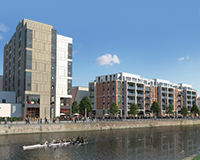 Considering its location, Bedford has failed to attract its fair share of investment. But a new wave of development opportunities are now putting it in the spotlight.
Considering its location, Bedford has failed to attract its fair share of investment. But a new wave of development opportunities are now putting it in the spotlight.
“There is a real shortage of industrial sites south of the A1/M1,” says Richard Last from local agent Brown & Lee. “Bedford is capitalising on that through a number of sites being brought forward along the A421 corridor.”
Recent coups include Travis Perkins’ purchase of 13 acres at Southall Estate’s Apex Bedford and Johnson Matthey taking the assignment of a lease on a 130,000 sq ft facility at Midway 130.
Rents are competitive, too. Lambert Smith Hampton’s Lloyd Spencer says: “If you brought a new 100,000 sq ft building to the market today, you would probably get £6.25 to £6.50 per sq ft, compared to nearer £7 in Milton Keynes.”
That discount is coupled with Bedford’s improved connectivity. When the A421 link opened in 2010, traffic was suddenly able to access the A1 from the M1 motorway in less than 10 minutes. The final section of the Bedford Western Bypass will be completed soon.
Kirkby & Diamond’s Andrew Clarke says: “That improved access has challenged people’s opinions of Bedford. It has opened up development land and given developers greater appetite to acquire sites.”
Graftongate, for example, has just secured planning permission to deliver 650,000 sq ft of industrial and logistics space at Bedford Connect. The 44-acre site in Kempston was brought to market by Bedford Borough Council and Graftongate with funder LondonMetric, and will provide units ranging from 76,000 sq ft to 418,000 sq ft.
Graftongate’s Henry Angell-James says the area was previously overlooked. “It has a great land supply for larger units, the labour force is strong and the road improvements have made it far more accessible,” he says. “That has forced people to take a second look.”
Graftongate is in discussions with LondonMetric about whether to develop any of the space speculatively.
“When developers do spec, the majority of buildings are let prior to practical completion,” says LSH’s Spencer. “If you have product to show occupiers, it unearths a lot of enquiries that wouldn’t otherwise be there.”
Gazeley has opted to spec a 240,000 sq ft unit at G Park Bedford and will begin construction later this year. Gazeley’s Bruce Topley says: “The overall balance of supply and demand is very healthy and in the core area for distribution, there is probably only three months of supply.”
Growing demand for well-located employment land has led Bedford council to bring a number of its strategic sites to market. The next will be 44-acre Marston Vale Innovation Park, which it will sell outright or develop via a joint venture.
Beyond Marston Vale, the council has a pipeline of employment sites to bring to market, and agents are confident they will interest developers. “Perceptions of the local authority have changed dramatically and its proactive approach is having a very positive impact on the town,” says Kirkby & Diamond’s Clarke.
Before the unitary authority was established seven years ago, the council had a poor relationship with developers. “Pre-2009, a developer would have to batter down the door with no great expectation of success,” says Clarke. “The council has now adopted a much more open-door approach, which has encouraged more investment.”
Bedford mayor Dave Hodgson says: “Developers no longer need to walk back and forth between the planners and transport trying to get things done. We recognise the need to make it as positive an experience as possible.”
Hodgson points to the recent arrival of inward investors, including Vision Modular Systems from Ireland and Lantmannen Unibake, which invested in a new factory in Bedford after being refused planning in Milton Keynes.
Bedford’s time in the shadows may be coming to an end.
Not just a London dormitory
Maintaining a focus on employment growth at a time when there is so much pressure to deliver residential development is critical if Bedford is to be regarded as more than just a commuter town.
Barton Willmore’s Steven Kosky says: “Figures from April 2015 indicate that Bedford needs a further 17,300 new homes over the 2012 to 2032 period. They are under considerable pressure to deliver.”
Given Bedford’s improved roads and 35-minute train journey to London, it attracts a significant number of residents who work outside the borough. Brown & Lee’s Richard Last says: “It is hoped Bedford’s chimney pots will help draw in employers. We don’t want all those people jumping onto a train or into a car to travel to work elsewhere.”
It is also critical that, in focusing on key motorway sites, the council does not take its eye off the ball in revitalising the town centre. It has been a long time since the centre of Bedford has attracted a significant development project and hopes are pinned on the success of new mixed-use scheme Riverside North.
Delivered through a joint venture between Coplan Estates and Henderson, the £150m development will include a seven-screen Vue cinema, a 100-bed Premier Inn hotel and restaurants including Zizzi, Chimichanga and Wagamama. The council, as landowner, has granted the developer a 250-year lease on the site, securing a long-term revenue stream. Construction is under way, with completion due in February 2017.
The scheme’s 64-unit residential component has been forward sold to Delph Property Group, and the rest of the scheme is already about 85% prelet.
“Bedford has traditionally punched below its weight,” says Coplan’s Colin McQueston. “It leaks significant spend to Milton Keynes, which is a much bigger leisure destination, and this scheme offers an opportunity to address that.”
Coplan has developed a strong relationship with the council, having invested elsewhere in the borough. McQueston says there is potential for further investment, and he has spoken to retailers such as H&M which are keen to invest in the town but can’t find the right type of unit. Coplan may look at providing new retail space, he adds.
Striking the right balance
 With so much of Bedford town centre’s office stock converted to residential use, has the pendulum swung too far?
With so much of Bedford town centre’s office stock converted to residential use, has the pendulum swung too far?
The county town’s office market has never had much pulling power. It was traditionally dependent on public-sector and insurance occupiers, both of which have largely abandoned the town centre. It is little wonder that many of those 1960s and 1970s buildings have since gone to alternative use.
“There has been around 400,000 sq ft of office space lost to permitted development rights over the past couple of years,” says Kirkby & Diamond’s Andrew Clarke. “There was once a genuine oversupply, but I think we’re at the point where enough is enough.”
Where decent space is being offered, such as the serviced office I-lab units at Priory Business Park, they tend to do well. The problem is, they are few and far between. With town-centre office rents languishing at £10 to £12 per sq ft, speculative development is not viable.
Marston Vale (see main text) may eventually provide new offices and there are hopes that once Bedford’s railway station is finally redeveloped, it will attract mixed-use development. However, both are some way off.
In the meantime, opportunistic developer Verve Properties is reaping the rewards of refurbishing Bedford Heights (pictured), a 230,000 sq ft office building on Manton Lane that has been undergoing major renovation since it was purchased in 2014.
“We have benefited from demand from occupiers displaced through PDR,” says Verve’s Tim Payne. “Our occupancy is around 85% and rents have risen from £8 to £10 per sq ft in 18 months.”











